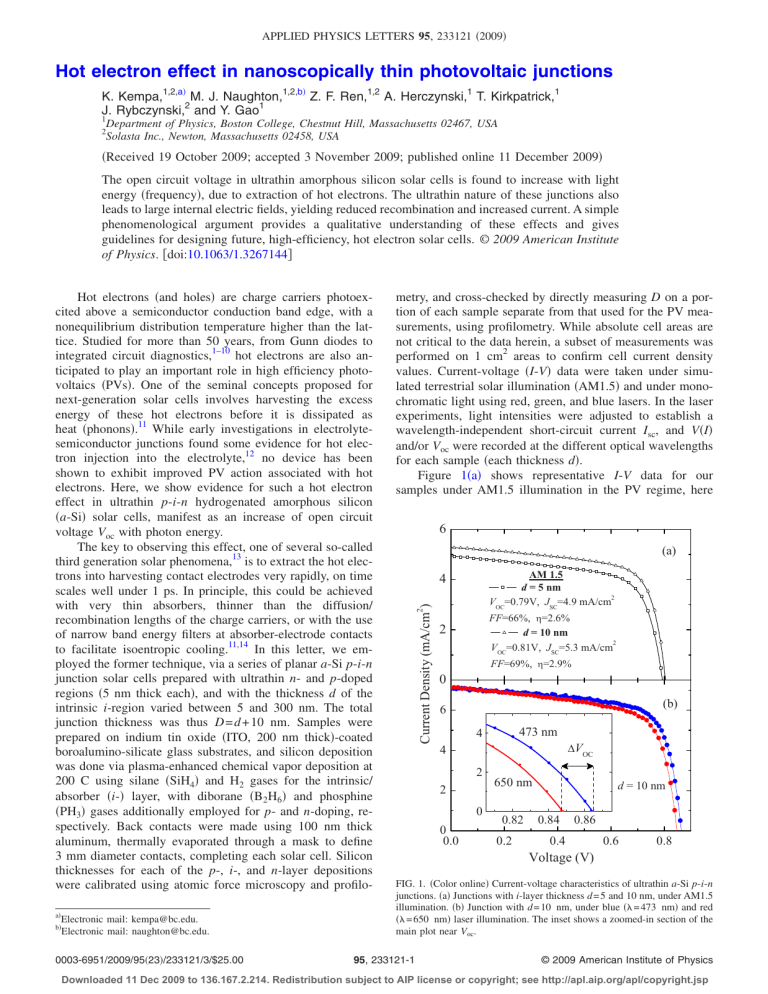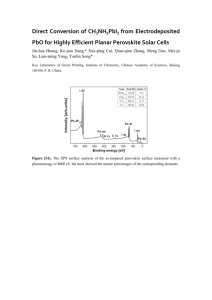Hot electron effect in nanoscopically thin photovoltaic junctions K. Kempa,
advertisement

APPLIED PHYSICS LETTERS 95, 233121 共2009兲 Hot electron effect in nanoscopically thin photovoltaic junctions K. Kempa,1,2,a兲 M. J. Naughton,1,2,b兲 Z. F. Ren,1,2 A. Herczynski,1 T. Kirkpatrick,1 J. Rybczynski,2 and Y. Gao1 1 Department of Physics, Boston College, Chestnut Hill, Massachusetts 02467, USA Solasta Inc., Newton, Massachusetts 02458, USA 2 共Received 19 October 2009; accepted 3 November 2009; published online 11 December 2009兲 The open circuit voltage in ultrathin amorphous silicon solar cells is found to increase with light energy 共frequency兲, due to extraction of hot electrons. The ultrathin nature of these junctions also leads to large internal electric fields, yielding reduced recombination and increased current. A simple phenomenological argument provides a qualitative understanding of these effects and gives guidelines for designing future, high-efficiency, hot electron solar cells. © 2009 American Institute of Physics. 关doi:10.1063/1.3267144兴 a兲 Electronic mail: kempa@bc.edu. Electronic mail: naughton@bc.edu. b兲 0003-6951/2009/95共23兲/233121/3/$25.00 metry, and cross-checked by directly measuring D on a portion of each sample separate from that used for the PV measurements, using profilometry. While absolute cell areas are not critical to the data herein, a subset of measurements was performed on 1 cm2 areas to confirm cell current density values. Current-voltage 共I-V兲 data were taken under simulated terrestrial solar illumination 共AM1.5兲 and under monochromatic light using red, green, and blue lasers. In the laser experiments, light intensities were adjusted to establish a wavelength-independent short-circuit current Isc, and V共I兲 and/or Voc were recorded at the different optical wavelengths for each sample 共each thickness d兲. Figure 1共a兲 shows representative I-V data for our samples under AM1.5 illumination in the PV regime, here 6 (a) AM 1.5 d = 5 nm 2 VOC=0.79V, JSC=4.9 mA/cm 4 2 Current Density (mA/cm ) Hot electrons 共and holes兲 are charge carriers photoexcited above a semiconductor conduction band edge, with a nonequilibrium distribution temperature higher than the lattice. Studied for more than 50 years, from Gunn diodes to integrated circuit diagnostics,1–10 hot electrons are also anticipated to play an important role in high efficiency photovoltaics 共PVs兲. One of the seminal concepts proposed for next-generation solar cells involves harvesting the excess energy of these hot electrons before it is dissipated as heat 共phonons兲.11 While early investigations in electrolytesemiconductor junctions found some evidence for hot electron injection into the electrolyte,12 no device has been shown to exhibit improved PV action associated with hot electrons. Here, we show evidence for such a hot electron effect in ultrathin p-i-n hydrogenated amorphous silicon 共a-Si兲 solar cells, manifest as an increase of open circuit voltage Voc with photon energy. The key to observing this effect, one of several so-called third generation solar phenomena,13 is to extract the hot electrons into harvesting contact electrodes very rapidly, on time scales well under 1 ps. In principle, this could be achieved with very thin absorbers, thinner than the diffusion/ recombination lengths of the charge carriers, or with the use of narrow band energy filters at absorber-electrode contacts to facilitate isoentropic cooling.11,14 In this letter, we employed the former technique, via a series of planar a-Si p-i-n junction solar cells prepared with ultrathin n- and p-doped regions 共5 nm thick each兲, and with the thickness d of the intrinsic i-region varied between 5 and 300 nm. The total junction thickness was thus D = d + 10 nm. Samples were prepared on indium tin oxide 共ITO, 200 nm thick兲-coated boroalumino-silicate glass substrates, and silicon deposition was done via plasma-enhanced chemical vapor deposition at 200 C using silane 共SiH4兲 and H2 gases for the intrinsic/ absorber 共i-兲 layer, with diborane 共B2H6兲 and phosphine 共PH3兲 gases additionally employed for p- and n-doping, respectively. Back contacts were made using 100 nm thick aluminum, thermally evaporated through a mask to define 3 mm diameter contacts, completing each solar cell. Silicon thicknesses for each of the p-, i-, and n-layer depositions were calibrated using atomic force microscopy and profilo- FF=66%, η=2.6% d = 10 nm 2 VOC=0.81V, JSC=5.3 mA/cm 2 FF=69%, η=2.9% 0 (b) 6 473 nm 4 ∆VOC 4 2 2 0 0 0.0 650 nm 0.82 0.2 d = 10 nm 0.84 0.86 0.4 0.6 0.8 Voltage (V) FIG. 1. 共Color online兲 Current-voltage characteristics of ultrathin a-Si p-i-n junctions. 共a兲 Junctions with i-layer thickness d = 5 and 10 nm, under AM1.5 illumination. 共b兲 Junction with d = 10 nm, under blue 共 = 473 nm兲 and red 共 = 650 nm兲 laser illumination. The inset shows a zoomed-in section of the main plot near Voc. 95, 233121-1 © 2009 American Institute of Physics Downloaded 11 Dec 2009 to 136.167.2.214. Redistribution subject to AIP license or copyright; see http://apl.aip.org/apl/copyright.jsp 233121-2 Appl. Phys. Lett. 95, 233121 共2009兲 Kempa et al. 0.08 8 quasistatic static Eqn. (1) 1 6 2 Jsc (mA/cm ) e∆Voc / h∆ω 0.04 0.00 -0.04 Jsc 4 Jsc[I-V] Jsc[EQE] A P/P(60 nm) A/A(60 nm) -0.08 Zh u, et al . 2 0 50 100 150 200 250 300 0 350 i-layer thickness d (nm) 10 20 30 40 50 60 0 D (nm) FIG. 2. 共Color online兲 Open-circuit voltage change vs junction thickness. ⌬Voc from all PV experiments involving lasers, normalized by the difference in the corresponding photon energies per charge ប⌬ / e, vs i-layer thickness d for fixed Jsc. Symbols represent the mean values, and the error bars are obtained from the standard deviations. The solid line is obtained by using Eq. 共1兲. The largest effect measured was ⌬Voc = 40 mV for d = 5 nm. for our two thinnest i-layer samples, d = 5 and 10 nm 共D = 15 and 20 nm兲. These data demonstrate the high quality of the junctions, even with the ultrathin, 5 nm thick n- and p-layers. Note that this D = 15 nm sample still achieved over 2.5% power conversion efficiency, a point to which we return later. Similar data were taken not under AM1.5 light, but under monochromatic laser light using lasers 共RGBLase LLC兲. Figure 1共b兲 shows I-V data for the d = 10 nm sample for blue 共 = 473 nm兲 and red 共 = 650 nm兲 illumination, with each laser intensity adjusted 共via a diffusing lens兲 to assure the same Isc 共and thus short circuit current density Jsc兲. Here, it can be seen that there is an increase in Voc for higher blue energy light over that of lower energy, with ⌬Voc = Voc red − Voc = 16.7⫾ 1.1 mV. Similar I-V data were taken for samples with d = 5, 20, 50, 100, and 300 nm and ⌬Voc was extracted for each sample. To eliminate possible artifacts due to quasistatic transients 共laser instabilities, ohmic heating, etc.兲, we performed, in parallel, quasistatic measurements for all samples and lasers, using a set-up that assures collection of data with rapid switching between open circuit voltage Voc and closed circuit current Isc configurations. The results are in excellent agreement with the static results based on the complete I-V data, showing that the quasistatic transients are negligible. Combined results from all experiments involving lasers are shown in Fig. 2, where we plot ⌬Voc obtained as above as blue green − Voc 共all normalized by the difference in well as via Voc the corresponding photon energies per charge ប⌬ / e, where ប is Planck’s constant and e is the electron charge兲 versus d for fixed Jsc = 7.1 mA/ cm2, with symbols representing the mean values and error bars obtained from the standard deviations. With the employed normalization, the data congregate around a single line, which has the following phenomenological form: e⌬Voc Dc + ␣ + D, = ប⌬ D 0 共1兲 where ប⌬ / e = 2.62 eV− 2.20 eV= 0.42 eV 共for blue-green data兲, and ប⌬ / e = 2.62 eV− 1.91 eV= 0.71 eV 共for blue- FIG. 3. 共Color online兲 Variation of short circuit current density with total junction thickness. Jsc vs D under AM1.5 illumination, as measured from I-Vs 共squares兲, calculated by integrating EQE共兲 共triangles兲, integrated optical absorbance A, normalized to the D = 60 nm value 共circles兲, and normalized power density as modeled in Ref. 17 共dash兲. red data兲, and the adjustable constants are Dc = 1.3 nm, ␣ = −0.03, and  = −1.2⫻ 10−4 nm−1. Figure 2 represents the main result of this work: ⌬Voc is positive for ultrathin junctions, decreases monotonically with i-layer thickness d, and becomes negative for d ⬎ 30 nm. This effect is quantitatively captured by Eq. 共1兲, and can be explained by employing a simple argument. As stated earlier, hot electrons are generated by photons with ប ⬎ Eg, where is the photon frequency and Eg the energy gap of the absorbing semiconductor. These hot electrons rapidly thermalize via direct phonon emission and indirect cooling through collisions with cold electrons in the doped regions, on a time scale of 0.1 ps.7 Only a small fraction, of order Dc / D, of these hot electrons, generated within a very small distance Dc of the order of 1 nm away from the collector,5,15 can be extracted with their original kinetic energy 共ប − Eg兲. The ensemble-averaged energy of the electrons arriving at the collector is therefore Eavg ⬃ 共ប − Eg兲Dc / D, and the resulting increase of Voc is ⌬Voc ⬇ 关共ប⌬兲 / e兴共Dc / D兲. This is the positive contribution which decreases monotonically with D 共⌬Voc ⬃ 1 / D兲. The remaining hot electrons cool off by emitting phonons, which results in a temperature increase of the junction. This increase is proportional to the initial kinetic energy of the thermalizing electrons rapidly delivering energy to the thermal bath. The temperature is also expected to increase linearly with the number of thermalizing hot electrons, which in turn is proportional to D − Dc ⬇ D. Therefore, the temperature increment corresponding to this effect is ⌬T ⬃ ប⌬D. It is well known that increasing temperature only reduces Voc in solar cells, with typically linear dependence near room temperature,15 so that ⌬Voc ⬃ −⌬T ⬃ −D. Thus, hot electrons contribute to both the 1 / D increase for small D and the linear decrease for large D, of Voc. Combining both contributions, along with a D-independent term ␣, yields Eq. 共1兲. With Dc = 1.3 nm, of order of the 1 nm estimate above, we obtain the solid line in Fig. 2, which follows the measured data rather well. This phenomenological agreement strongly supports our interpretation of the data in Fig. 2 as an interplay between two competing effects: an increase of Voc with light energy 共i.e. ⌬Voc ⬎ 0兲 in ultrathin Downloaded 11 Dec 2009 to 136.167.2.214. Redistribution subject to AIP license or copyright; see http://apl.aip.org/apl/copyright.jsp 233121-3 Appl. Phys. Lett. 95, 233121 共2009兲 Kempa et al. samples due to extracted hot electrons 共a solid-state analog of the photoelectric effect兲,16 and a decrease of Voc 共⌬Voc ⬍ 0兲 in thicker samples associated with unextracted hot electrons losing their energy to heat. The observation of a measurable hot electron effect in our junctions is facilitated by the exceptionally short carrier escape time, due to the nanoscopic junction thickness. This small thickness also increases the junction electric field, increasing carrier velocities. This leads also to the anomalously large current observed: the Jsc of the ultrathin film samples 共d = 5 to 20 nm兲 under 1 sun is relatively large, 5 mA/ cm2 关Fig. 1共a兲兴, already half that obtained for conventional 共d ⬃ 400 nm兲 planar cells. Figure 3 reveals the reasons for this unusual behavior. First, the integrated optical absorbance A 共shown normalized to the D = 60 nm value兲 which governs the PV current for thin films, decreases with decreasing D, as expected, because thinner junctions absorb less light. Likewise, the dashed line representing a model by Zhu et al.,17 of converted solar power as a function of film thickness in p-i-n a-Si solar cells, falls to zero as D → 0. However, the transport Jsc, as well as that derived from the wavelengthintegrated external quantum efficiency, deviate from this behavior for small D. This indicates that there is an improved extraction of carriers for ultrathin layers, sufficiently strong to overcome the reduced light absorption. We attribute this deviation to the very high junction electric field 共⬃108 V / m兲, which varies as 1 / D and serves to reduce carrier recombination.18 The overall power conversion efficiency of these ultrathin cells is thus enhanced by both excess voltage 共hot electron effect兲 and excess current 共high electric field effect兲, approaching ⬃ 3% with absorbers less than 1/50th as thick as conventional cells. Practically speaking, however, this efficiency is limited by the essentially negligible light collection of such ultrathin junctions. On the other hand, with improved light trapping schemes, such as via nanowire configurations,19 ultrathin hot electron solar cells could be engineered with significant increases in efficiency. In conclusion, we have found that the open circuit voltage Voc in ultrathin a-Si p-i-n solar cells increases with light energy. The observed increase is due to extraction of a residual population of hot electrons generated near the collector. The effect naturally changes sign for thick junctions, as hot electrons thermalize to the lattice and warm the junction. In addition to the observed hot electron-induced voltage changes, the ultrathin nature of the junctions leads to large internal electric fields, yielding reduced carrier recombination and increased current. A simple phenomenological argument provides a qualitative understanding of these effects, and gives guidelines for designing future, high-efficiency, hot electron solar cells. J. B. Gunn, Solid State Commun. 1, 88 共1963兲. H. Kroemer, Proc. IEEE 52, 1736 共1964兲. 3 D. Frohman-Bentchkowsky, Appl. Phys. Lett. 18, 332 共1971兲. 4 M. Heiblum, M. I. Nathan, D. C. Thomas, and C. M. Knoedler, Phys. Rev. Lett. 55, 2200 共1985兲. 5 C. Rauch, G. Strasser, K. Unterrainer, W. Boxleitner, K. Kempa, and E. Gornik, Physica E 共Amsterdam兲 2, 282 共1998兲. 6 A. Othonos, J. Appl. Phys. 83, 1789 共1998兲. 7 J. R. Goldman and J. A. Prybyla, Phys. Rev. Lett. 72, 1364 共1994兲. 8 S. M. Sze, High-Speed Semiconductor Devices 共Wiley, New York, 1990兲. 9 K. M. Kramer and W. N. G. Hitchon, Semiconductor Devices: A Simulation Approach 共Prentice Hall, New Jersey, 1997兲. 10 J. A. Kash and J. C. Tsang, J. Cryst. Growth 210, 318 共2000兲. 11 R. T. Ross and A. J. Nozik, J. Appl. Phys. 53, 3813 共1982兲. 12 J. A. Turner and A. J. Nozik, Appl. Phys. Lett. 41, 101 共1982兲. 13 M. A. Green, Third Generation Photovoltaics: Advanced Solar Energy Conversion 共Springer, Berlin, 2006兲. 14 P. Würfel, Sol. Energy Mater. Sol. Cells 46, 43 共1997兲. 15 See, for example, M. Cardona, T. A. Meyer, and M. L. W. Thewalt, Phys. Rev. Lett. 92, 196403 共2004兲. 16 H. Hertz, Ann. d. Physik 31, 983 共1887兲. 17 K. Zhu, J. Yang, W. Wang, E. A. Schiff, J. Liang, and S. Guha, Mater. Res. Soc. Symp. Proc. 762, 218 共2003兲. 18 M. Pope and H. C. Brenner, Synth. Met. 141, 185 共2004兲. 19 J. Rybczynski, K. Kempa, A. Herczynski, Y. Wang, M. J. Naughton, Z. F. Ren, Z. P. Huang, D. Cai, and M. Giersig, Appl. Phys. Lett. 90, 021104 共2007兲. 1 2 Downloaded 11 Dec 2009 to 136.167.2.214. Redistribution subject to AIP license or copyright; see http://apl.aip.org/apl/copyright.jsp




